Pavilion to Watson to Darwin
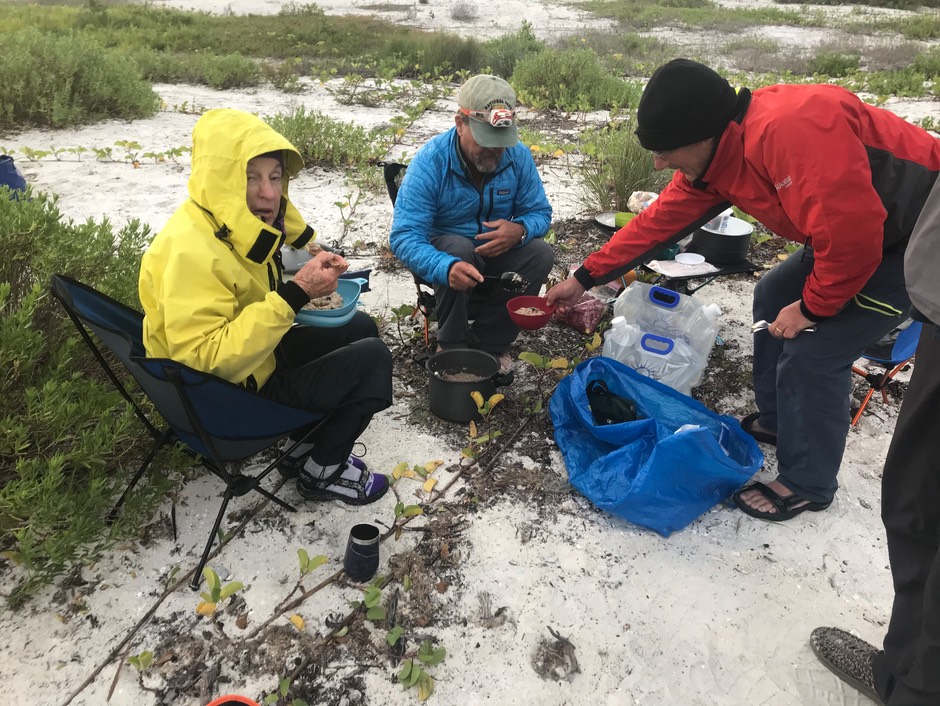
Day 2: Monday dawned cold and overcast, with a light rain falling. Overnight temperatures had been in the low 50’s, and there was a bitter wet wind blowing when we emerged from our tents as dawn tried to show itself above the eastern horizon. We huddled around our single burner campfire clutching warm cups of coffee, as Joel prepared a hardy oatmeal concoction for breakfast.
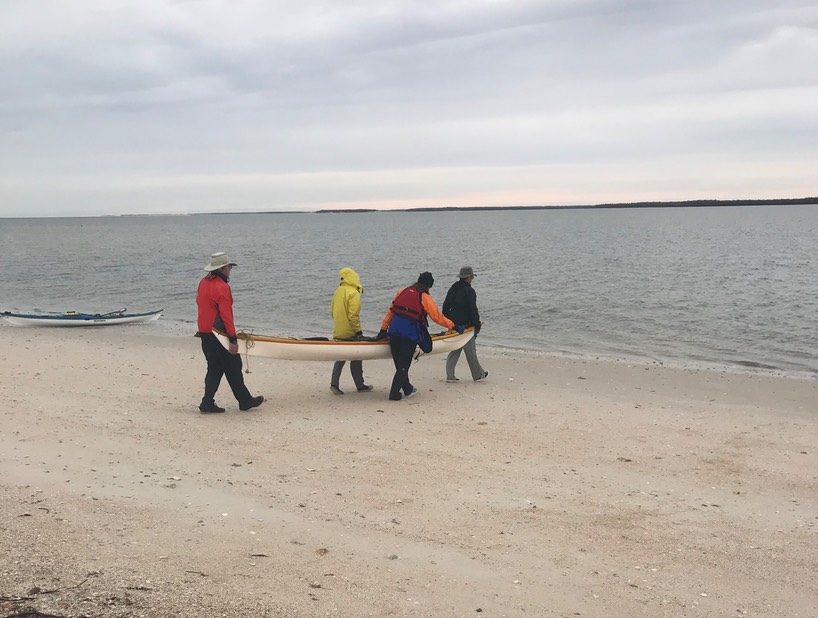
Our goal was to be packed and on the water by 9:00 am. When our camp gear had all been carefully stowed in our boats, we carried them to the water, launching into the Gulf just before 8:50 am. Our route today would take us east southeast toward the point where the Chatham River flows into the Gulf. But first we took an upwind jaunt toward and around Duck Rock to check out a large colony of white pelicans.
If brown pelicans (the East Coast’s diving variety) could be called the “country mouse” as in the old fable, white pelicans are definitely the “city mouse”. They are huge and elegant, with a wing span of some nine feet. They are more than twice the size of their brown cousins when standing side by side. They are a beautiful snowy white when on the ground and in the water. But flight exposes a fringe of black feathers along the underside of their enormous wings. They have a long pointed beak and no pouch, as they are surface feeders rather than divers. They hunt in groups forming a circle and slowly herding small fish together in the center where they can scoop them up. There must have been more than one hundred birds in this group. We stopped at a safe distance so as to not disturb them and watched for a while, then resumed our journey toward the Chatham River.
The entrance to the Chatham can be hard to find as it is choked with mangrove islands. However, on this day we had no trouble finding our way through these islands and into the main body of the river. The Chatham is beautiful, broad in many places, and heavily treed. As we paddled east (I’m temped to say upstream, but this is a brackish tidal river, so upstream and downstream are defined by incoming or out going tides) we passed enormous Calusa shell mound islands to our left. Here and there could be seen the remnants of channels created by the Calusa’s so many hundreds of years ago as a way to easily access the center of these incredible manmade landforms.
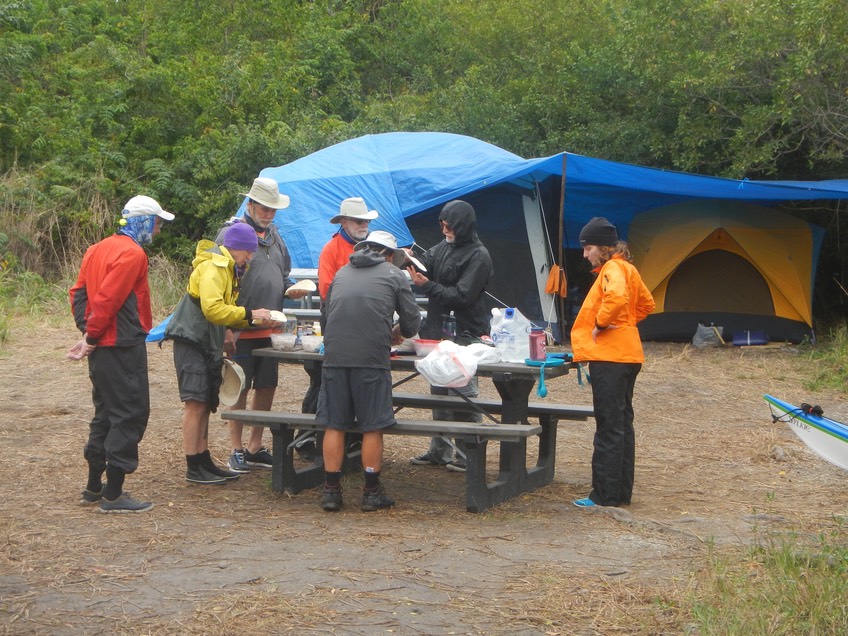
About two thirds of the way up from the Gulf to Chevelier Bay is Watson’s Place, situated on a thirty plus acre shell mound island facing a bend that forms a wide place in the river. I had camped here on an earlier trip some years before. It’s a beautiful spot and full of Florida history. The story of Ed Watson, his sugar plantation here where several murders are thought to have occurred, and his assassination by twenty-three of his neighbors at Smallwood’s Store on Chocoloskee Island in the early 1900’s makes for a great read (see “Killing Mister Watson” by Peter Matthiessen).
We pulled ashore along a narrow area next to a dock used by powerboaters. Perched the far end sat a big blue porta-potty, the dock and the outhouse being the only things reminding us that we were not in a true wilderness. Some powerboaters had set up two tents at one side of the large site and covered both of them with an enormous blue tarp. Looking at this setup, the difference between powerboat campers and paddlers was very obvious, as nothing they had would even begin to fit in a canoe or kayak.
As we gathered around a picnic table, Joel called for certain lunch fixings and two paddlers scrambled to find what he had asked for in their boats. I don’t remember what we had, but I remember that it tasted good and filled me up. I noticed that the old caldron Watson used to boil the liquid he squeezed from his cane into syrup, was still there, as was the foundation of his once beautiful house and a nearby cistern.
After lunch, we continued East on the Chatham, finally reaching Chevelier Bay. Jean Chevelier was the first resident of our next stop, Darwin’s Place on Possum Key. He was a plume hunter and an ornithologist who collected bird specimens. It’s reported that he went mad looking for hidden Calusa treasure. Arthur Darwin, a notable Everglades hermit, arrived at Possum Key in 1945, living there in a concrete house without running water or electricity, until his death in 1977 at the remarkable age of 112. He was allowed to remain on Possum Key until his death, after it became part of Everglades National Park.
By noon the the rain had passed and the day had warmed considerably, showing a clear blue sky. As we paddled through the bay, completely surrounded by mangrove forests, the only sounds we could hear were the dipping of our paddle blades as we moved in the still water, the occasional call of a bird, and the beating of its wings. Bruce, who had GPS coordinates for most of our camping locations, paddled on ahead with Rebecca. We were concerned that they might pass our stopping point, but Darwin’s Place was easy to spot. When we arrived, they were there. We had traveled about 13 miles.
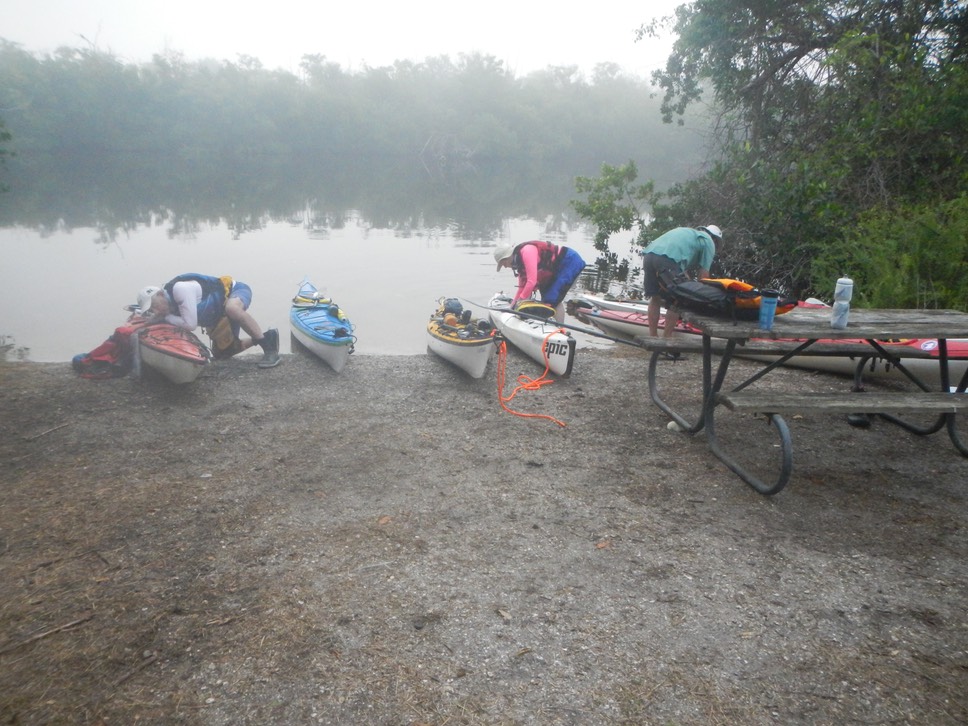
Darwin’s place had a broad beach making for an easy landing and take out. The camping area was wide and open. If the campsite was located where Darwin’s house and cistern were built, they had been completely removed. We saw no evidence of their existence during our visit.
As we began to pull gear out of our kayaks and look for places to pitch our tents, Joe approached Phill to ask him where he planned to place his tent, as Phil apparently snored loudly all night and Joe, a light sleeper, got no rest. Joe just wanted to place his tent as far away from Phil as possible. A few others had heard Phil as well, but not me. I can sleep through all kinds of noise, which at times can be a little scary. I felt bad for Phil as I watched him carry his gear to the farthest corner of the site to set up by himself. Joel, feeling supportive I guess, joined him because he always slept with ear plugs. Snoring didn’t bother him.
When Bruce tried to open his back hatch to get his tent, the darned cover just broke apart. It was a rubber hatch cover made by Valley Kayaks and is used widely on many different boats. They do a great job keeping hatches dry but are prone to coming apart without warning, at the most inopportune times. (I’ve replaced all of my Valley hatch covers with a brand that does not have this problem.) With six more days of paddling ahead, some of it on the Gulf of Mexico, a field repair was required, as an open hatch could fill with water and cause a boat to swamp. But what to do? A small crowd of folks offering suggestions gathered around and then drifted away until only Bruce and Rebecca remained. Rebecca had a brilliant idea. Pulling a mylar space blanket from her gear, she placed several layers of mylar over the open hatch, then cinched the whole thing in place with a 1/8 inch nylon cord, using a trucker’s knot that could be applied and removed as necessary. It was an elegant fix.
At about the same time, Karol found several cups of water in her back hatch, Her hatches were solid fiberglass and didn’t seem to be the source of the water. Eventually the problem was traced to some ill fitting hardware on her combination rudder/skeg. After some fussing they had what she and Farley thought was a good repair. Finding two leaky boats on the second day of an eight day kayak trip was a bit worrisome, but we believed our repairs would get us through.
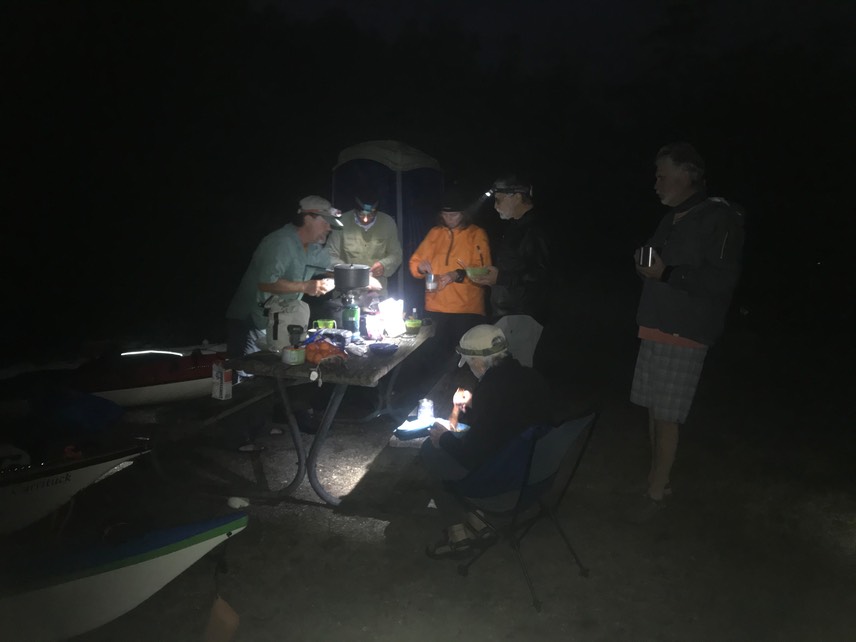
As dusk settled around us, the wine bladders came out making the most difficult decision of the evening being, would it be red or white? This was a ritual I couldn’t participate in as I don’t drink. But it did seem to add to the feeling of camaraderie in the group. Once again we were gathered around our little propane campfire as Joel miraculously prepared dinner for the eight of us in his little pressure cooker. Dinner was served after dark had enveloped our group. The bobbing of moving heads adorned with headlamps lit up the night as we ate. Once our dishes were washed folks drifted off to their tents. Joel said we needed an early start in the morning to take advantage of a falling tide. Launch time would be before 8:00 am. Soon the site was quiet, broken only by the sounds of people breathing nearby and Phil’s now distant snore.
Day 2 Video Summary
Next Page: On the Wilderness trail